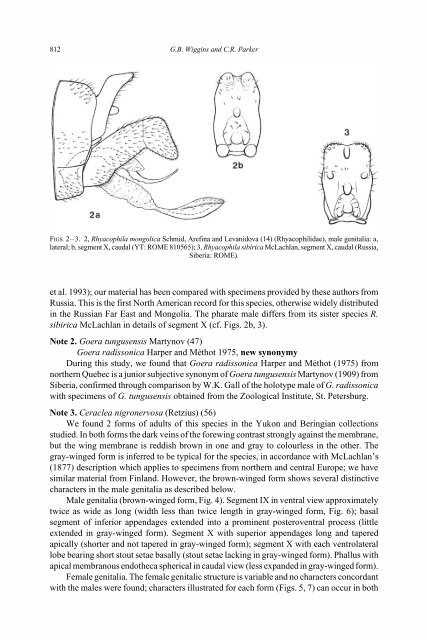Caddisflies of the Yukon - Department of Biological Sciences ...
Caddisflies of the Yukon - Department of Biological Sciences ...
Caddisflies of the Yukon - Department of Biological Sciences ...
Create successful ePaper yourself
Turn your PDF publications into a flip-book with our unique Google optimized e-Paper software.
812 G.B. Wiggins and C.R. Parker<br />
FIGS. 2 – 3. 2, Rhyacophila mongolica Schmid, Arefina and Levanidova (14) (Rhyacophilidae), male genitalia: a,<br />
lateral; b, segment X, caudal (YT: ROME 810565); 3, Rhyacophila sibirica McLachlan, segment X, caudal (Russia,<br />
Siberia: ROME).<br />
et al. 1993); our material has been compared with specimens provided by <strong>the</strong>se authors from<br />
Russia. This is <strong>the</strong> first North American record for this species, o<strong>the</strong>rwise widely distributed<br />
in <strong>the</strong> Russian Far East and Mongolia. The pharate male differs from its sister species R.<br />
sibirica McLachlan in details <strong>of</strong> segment X (cf. Figs. 2b, 3).<br />
Note 2. Goera tungusensis Martynov (47)<br />
Goera radissonica Harper and Méthot 1975, new synonymy<br />
During this study, we found that Goera radissonica Harper and Méthot (1975) from<br />
nor<strong>the</strong>rn Quebec is a junior subjective synonym <strong>of</strong> Goera tungusensis Martynov (1909) from<br />
Siberia, confirmed through comparison by W.K. Gall <strong>of</strong> <strong>the</strong> holotype male <strong>of</strong> G. radissonica<br />
with specimens <strong>of</strong> G. tungusensis obtained from <strong>the</strong> Zoological Institute, St. Petersburg.<br />
Note 3. Ceraclea nigronervosa (Retzius) (56)<br />
We found 2 forms <strong>of</strong> adults <strong>of</strong> this species in <strong>the</strong> <strong>Yukon</strong> and Beringian collections<br />
studied. In both forms <strong>the</strong> dark veins <strong>of</strong> <strong>the</strong> forewing contrast strongly against <strong>the</strong> membrane,<br />
but <strong>the</strong> wing membrane is reddish brown in one and gray to colourless in <strong>the</strong> o<strong>the</strong>r. The<br />
gray-winged form is inferred to be typical for <strong>the</strong> species, in accordance with McLachlan’s<br />
(1877) description which applies to specimens from nor<strong>the</strong>rn and central Europe; we have<br />
similar material from Finland. However, <strong>the</strong> brown-winged form shows several distinctive<br />
characters in <strong>the</strong> male genitalia as described below.<br />
Male genitalia (brown-winged form, Fig. 4). Segment IX in ventral view approximately<br />
twice as wide as long (width less than twice length in gray-winged form, Fig. 6); basal<br />
segment <strong>of</strong> inferior appendages extended into a prominent posteroventral process (little<br />
extended in gray-winged form). Segment X with superior appendages long and tapered<br />
apically (shorter and not tapered in gray-winged form); segment X with each ventrolateral<br />
lobe bearing short stout setae basally (stout setae lacking in gray-winged form). Phallus with<br />
apical membranous endo<strong>the</strong>ca spherical in caudal view (less expanded in gray-winged form).<br />
Female genitalia. The female genitalic structure is variable and no characters concordant<br />
with <strong>the</strong> males were found; characters illustrated for each form (Figs. 5, 7) can occur in both
















